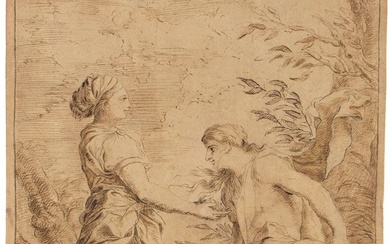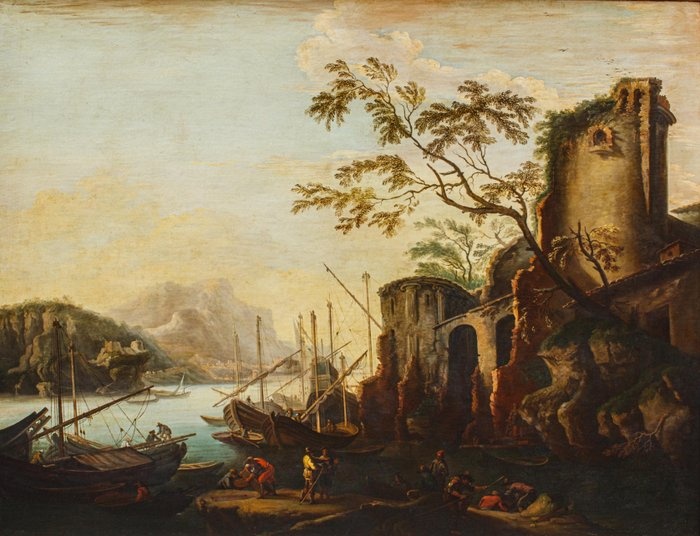Salvator Rosa (1615-1673), Da - Marina con pescatori
Late 17th century, by Salvator Rosa
Marina with fishermen
Oil on canvas, 100 x 126 cm - With frame, 111 x 136 cm
Exemplified on the canvas of the same name by Salvator Rosa (1615-1673) , now preserved in the Palatine Gallery of Palazzo Pitti, the work depicts a Marina at sunset with boats, fishermen, and ruins of a castle. The Florentine painting, coming from the Ricciardi house, was painted during Rosa's Florentine period for Cardinal Giancarlo de Medici. The canvas is a pendant for another painting, also kept in Palazzo Pitti, depicting the Bridge; the two paintings were created by the painter immediately after 1640 and are still linked to a style of painting that shows a new refinement in the tonal rendering of the landscape which he immediately acquired in Rome and reconciled with his own natural tendency towards a type of varied and picturesque, very similar to the View of the Gulf in the Estense Gallery in Modena and other Modena paintings of that year. There are some copies of paintings that attest to his celebrity, among the most characteristic of Rosa's early production, such as the copy of the painting preserved at Corsham Court.
A pupil in his native land of Fracanzano, of Jusepe de Ribera and of Aniello Falcone, a battle fighter, Rosa moved to Rome in 1635 thanks to the protection of Cardinal Brancacci where he met the bamboccianti and the work of Peter van Laer and Cerquozzi who had an innovative attitude towards nature in opposition to the heavy and academic Roman Baroque. A classicist change in his style dates back to the years 1639-1640, due to the influence of Claude Lorrain, Nicolas Poussin and Pietro Testa, evident in the conception of the landscape, which however is compatible with the artist's own sensitivity for the rendering of picturesque aspects of nature. He will soon renounce that pictorial language of the Bamboccianti School, to enter the workshop of the painter Jusepe de Ribera, known as Spagnoletto, faithful continuer of Caravaggio's luminism, creator of a dramatic and dark painting, rich in striking chiaroscuro effects.
Rosa's works masterfully convey the tension between creation and the human element, of which the material smallness and impotence towards nature are highlighted, elements that also emerge in the pair of paintings analyzed here, where the human figure becomes minute in front of the majesty of the suggestive landscape.
The frame is provided free of charge, therefore it cannot be a reason for return or complaint.
For paintings purchased abroad: after payment the procedure to obtain the export license (ALC) will be started. All antiques sent abroad from Italy require this document, issued by the Minister of Cultural Heritage. The procedure could take 2 to 4 weeks from the request, therefore, as soon as we have the document the painting will be sent.
View it on
Estimate
Time, Location
Auction House
Late 17th century, by Salvator Rosa
Marina with fishermen
Oil on canvas, 100 x 126 cm - With frame, 111 x 136 cm
Exemplified on the canvas of the same name by Salvator Rosa (1615-1673) , now preserved in the Palatine Gallery of Palazzo Pitti, the work depicts a Marina at sunset with boats, fishermen, and ruins of a castle. The Florentine painting, coming from the Ricciardi house, was painted during Rosa's Florentine period for Cardinal Giancarlo de Medici. The canvas is a pendant for another painting, also kept in Palazzo Pitti, depicting the Bridge; the two paintings were created by the painter immediately after 1640 and are still linked to a style of painting that shows a new refinement in the tonal rendering of the landscape which he immediately acquired in Rome and reconciled with his own natural tendency towards a type of varied and picturesque, very similar to the View of the Gulf in the Estense Gallery in Modena and other Modena paintings of that year. There are some copies of paintings that attest to his celebrity, among the most characteristic of Rosa's early production, such as the copy of the painting preserved at Corsham Court.
A pupil in his native land of Fracanzano, of Jusepe de Ribera and of Aniello Falcone, a battle fighter, Rosa moved to Rome in 1635 thanks to the protection of Cardinal Brancacci where he met the bamboccianti and the work of Peter van Laer and Cerquozzi who had an innovative attitude towards nature in opposition to the heavy and academic Roman Baroque. A classicist change in his style dates back to the years 1639-1640, due to the influence of Claude Lorrain, Nicolas Poussin and Pietro Testa, evident in the conception of the landscape, which however is compatible with the artist's own sensitivity for the rendering of picturesque aspects of nature. He will soon renounce that pictorial language of the Bamboccianti School, to enter the workshop of the painter Jusepe de Ribera, known as Spagnoletto, faithful continuer of Caravaggio's luminism, creator of a dramatic and dark painting, rich in striking chiaroscuro effects.
Rosa's works masterfully convey the tension between creation and the human element, of which the material smallness and impotence towards nature are highlighted, elements that also emerge in the pair of paintings analyzed here, where the human figure becomes minute in front of the majesty of the suggestive landscape.
The frame is provided free of charge, therefore it cannot be a reason for return or complaint.
For paintings purchased abroad: after payment the procedure to obtain the export license (ALC) will be started. All antiques sent abroad from Italy require this document, issued by the Minister of Cultural Heritage. The procedure could take 2 to 4 weeks from the request, therefore, as soon as we have the document the painting will be sent.
Estimate
Time, Location
Auction House
Similar Items

Rosa, Salvator Germany Login

Rosa, Salvator Germany Login





